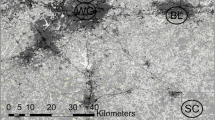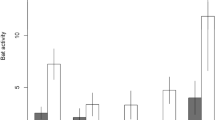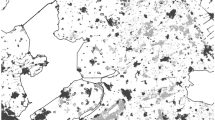Abstract
Passive acoustic monitoring of bats allows for the long-term surveillance of activity, thereby often leading to large amounts of data. No peer-reviewed published studies exist estimating the number of nights needed to deploy passive acoustic monitors to determine the cave-exiting behavior of hibernating bats in temperate climate zones. We used acoustic data recorded from the two most prominent bat species in the caves we studied and predicted that an asymptotic relationship existed between relative precision in the cave-exiting behavior (i.e., mean number of acoustic files/night) and number of nights acoustic detectors were deployed. We set detectors from 2011 to 2018 at 9 cave entrances during hibernation. We used 5000 bootstrapped draws for each sampled night, at each cave, and for each year by species to determine the number of nights needed to acoustically sample. Detectors recorded 3045 files of Townsend’s big-eared bats (Corynorhinus townsendii) across 443 detector nights and 11,377 files of western small-footed myotis (Myotis ciliolabrum) across 736 detector nights. The number of nights needed to estimate the mean cave-exiting behavior of Townsend’s big-eared bats was 18 and 17 for western small-footed myotis. Our methods used in other areas can help researchers understand the number of nights needed to set acoustic detectors in inclement weather and inhospitable locations to quantify potential changes in the winter cave-exiting behavior of bats.


Similar content being viewed by others
Data availability
The datasets generated during and/or analyzed during the current study are available from the corresponding author on reasonable request.
References
Bernard RF, McCracken GF (2017) Winter behavior of bats and the progression of white-nose syndrome in the southeastern United States. Ecol Evol 7:1487–1496. https://doi.org/10.1002/ece3.2772
Blumstein DT, Mennill DJ, Clemins P, Girod L, Yao K, Patricelli G, Deppe JL, Krakauer AH, Clark C, Cortopassi KA, Hanser SF, McCowan B, Ali AM, Kirschel ANG (2011) Acoustic monitoring in terrestrial environments using microphone arrays: applications, technological considerations and prospectus. J Appl Ecol 48:758–767
Bradfer-Lawrence T, Gardner N, Bunnefeld L, Bunnefeld N, Willis SG, Dent DH (2019) Guidelines for the use of acoustic indices in environmental research. Methods Ecol Evol 10:1796–1807
Britzke ER, Slack BA, Armstrong MP, Loeb SC (2010) Effects of orientation and weatherproofing on the detection of bat echolocation calls. J Fish Wildl Manag 1:136–141. https://doi.org/10.3996/072010-jfwm-025
Gibb R, Browning E, Glover-Kapfer P, Jones KE (2019) Emerging opportunities and challenges for passive acoustics in ecological assessment and monitoring. Methods Ecol Evol 10:169–185
Hammerson GA, Kling M, Harkness M, Ormes M, Young BE (2017) Strong geographic and temporal patterns in conservation status of North American bats. Biol Conserv 212:144–152. https://doi.org/10.1016/j.biocon.2017.05.025
Hicks LL, Schwab NA, Homyack JA, Jones JE, Maxell BA, Burkholder BO (2020) A statistical approach to white-nose syndrome surveillance monitoring using acoustic data. Plos One 15:e0241052
Humphrey SR, Kunz TH (1976) Ecology of a Pleistocene relict, the western big-eared bat (Plecotus townsendii), in the southern Great Plains. J Mammal 57:470–494. https://doi.org/10.2307/1379297
Klüg-Baerwald BJ, Gower LE, Lausen CL, Brigham RM (2016) Environmental correlates and energetics of winter flight by bats in southern Alberta, Canada. Can J Zool 94:829–836. https://doi.org/10.1139/cjz-2016-0055
Knudsen GR, Dixon RD, Amelon SK (2013) Potential spread of white-nose syndrome of bats to the Northwest: epidemiological considerations. Northwest Sci 87:292–306. https://doi.org/10.3955/046.087.0401
Lehnen L, Schorcht W, Karst I, Biedermann M, Kerth G, Puechmaille SJ (2018) Using approximate Bayesian computation to infer sex ratios from acoustic data. PLoS ONE 13:e0199428
Loeb SC, Rodhouse TJ, Ellison LE, Lausen CL, Reichard JD, Irvine KM, Ingersoll TE, Coleman JTH, Thogmartin WE, Sauer JR, Francis CM, Bayless ML, Stanley TR, Johnson DH (2015) A plan for the North American Bat Monitoring Program (NABat). Forest Service Research & Development, Southern Research Station General Technical Report SRS-208, Asheville, NC
Lohr SL (2019) Sampling: design and analysis. Chapman and Hall/CRC, New York
Mcloughlin MP, Stewart R, McElligott AG (2019) Automated bioacoustics: methods in ecology and conservation and their potential for animal welfare monitoring. J R Soc Interface 16:20190225
Nocera T, Ford WM, Silvis A, Dobony CA (2019) Patterns of acoustical activity of bats prior to and 10 years after WNS on Fort Drum Army Installation. New York. Global Ecol Conserv 18:e006333. https://doi.org/10.1016/j.gecco.2019.e00633
O’Farrell MJ, Gannon WL (1999) A comparison of acoustic versus capture techniques for the inventory of bats. J Mammal 80:24–30
R Core Team (2020) R: A language and environment for statistical computing. R Foundation for Statistical Computing, Vienna, Austria. (Version 4.3.0) URL https://www.R-project.org/
Reeder DM, Frank CL, Turner GG et al (2012) Frequent arousal from hibernation linked to severity of infection and mortality in bats with white-nose syndrome. PloS One 7:e38920. https://doi.org/10.1371/journal.pone.0038920
Revilla-Martín N, Budinski I, Puig-Montserrat X, Flaquer C, López-Baucells A (2020) Monitoring cave-dwelling bats using remote passive acoustic detectors: a new approach for cave monitoring. Bioacoustics 30:527–542. https://doi.org/10.1080/09524622.2020.1816492
Richardson SM, Lintott PR, Hosken DJ, Mathews F (2019) An evidence-based approach to specifying survey effort in ecological assessments of bat activity. Biol Conserv 231:98–102. https://doi.org/10.1016/j.biocon.2018.12.014
Sheffield SR, Shaw JH, Heidt GA, McClenaghan LR (1992) Guidelines for the protection of bat roosts. J Mammal 73:707–710
Sikes RS et al (2016) 2016 Guidelines of the American Society of Mammalogists for the use of wild mammals in research and education. J Mammal 97:663–688. https://doi.org/10.1093/jmammal/gyw078
Skalak SL, Sherwin RE, Brigham RM (2012) Sampling period, size and duration influence measures of bat species richness from acoustic surveys. Methods Ecol Evol 3:490–502. https://doi.org/10.1111/j.2041-210X.2011.00177.x
Stowell D, Sueur J (2020) Ecoacoustics: acoustic sensing for biodiversity monitoring at scale. Remote Sensing Ecol Conserv 6:217–219. https://doi.org/10.1002/rse2.174
Sugai LSM, Desjonqueres C, Silva TSF, Llusia D (2019) A roadmap for survey designs in terrestrial acoustic monitoring. Remote Sensing Ecol Conserv 6:220–235. https://doi.org/10.1002/rse2.131
Wackenhut MC (1990) Bat species overwintering in lava-tube caves in Lincoln, Gooding, Blaine, Bingham, and Butte counties, Idaho with special reference to annual return of banded Plecotus townsendii. Thesis, Idaho State University
Weller TJ, Rodhouse TJ, Neubaum DJ et al (2018) A review of bat hibernacula across the western United States: implications for white-nose syndrome surveillance and management. Plos One 13:e0205647. https://doi.org/10.1371/journal.pone.0205647
Whiting JC, Doering B, Wright G, Englestead DK, Frye JA, Stefanic T (2018a) Bat hibernacula in caves of southern Idaho: implications for monitoring and management. West North Am Nat 78:165–173
Whiting JC, Doering B, Wright G, Englestead DK, Frye JA, Stefanic T, Sewall BJ (2018b) Long-term bat abundance in sagebrush steppe. Sci Rep 8:12288
Whiting JC, Doering B, Aho K (2021) Long-term patterns of cave-exiting behavior of hibernating bats in nine caves in western North America. Sci Rep 11:8175. https://doi.org/10.1038/s41598-021-87605-0
Whiting JC, Doering B, Aho K (2022) Can acoustic recordings of cave-exiting bats in winter estimate bat abundance in hibernacula? Ecol Indic 137:108755
Whiting JC, Doering B, Pennock D (2019) Acoustic surveys for local, free-flying bats in zoos: an engaging approach for bat education and conservation. J Bat Res Conserv 12:94–99. https://doi.org/10.14709/BarbJ.12.1.2019.12
Acknowledgements
We thank the employees of Wastren Advantage.
Funding
This work was funded by the US Department of Energy, Idaho Operations Office at the INL Site (contract number DE-NE0008477).
Author information
Authors and Affiliations
Contributions
All authors contributed to the study conception and design. Material preparation, data collection, and analysis were performed by Jericho Whiting, Bill Doering, and Ken Aho. The first draft of the manuscript was written by Jericho Whiting, and all authors commented on previous versions of the manuscript. All authors read and approved the final manuscript.
Corresponding author
Ethics declarations
Ethics approval
Entering caves to count hibernating bats was approved by the Idaho National Laboratory Site Cave Protection and Access Committee (permit number OS-ESD-16–108).
Competing interests
The authors declare no competing interests.
Additional information
Communicated by: Jenna Kohles
Publisher's note
Springer Nature remains neutral with regard to jurisdictional claims in published maps and institutional affiliations.
Rights and permissions
Springer Nature or its licensor (e.g. a society or other partner) holds exclusive rights to this article under a publishing agreement with the author(s) or other rightsholder(s); author self-archiving of the accepted manuscript version of this article is solely governed by the terms of such publishing agreement and applicable law.
About this article
Cite this article
Whiting, J.C., Doering, B. & Aho, K. How many nights should acoustic detectors be set to estimate cave-exiting behavior of hibernating bats?. Mamm Res 68, 647–652 (2023). https://doi.org/10.1007/s13364-023-00709-y
Received:
Accepted:
Published:
Issue Date:
DOI: https://doi.org/10.1007/s13364-023-00709-y




